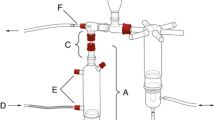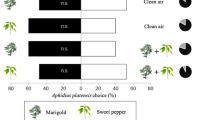Abstract
Plant volatile compounds induced by herbivore attack have been demonstrated to provide a signal to herbivore enemies such as parasitic wasps that use these volatiles to locate their hosts. However, in addition to herbivore-induced volatiles, plants often release volatiles constitutively. We assessed the interaction between herbivore-induced and constitutively released volatiles of maize in the attraction of the wasp Cotesia marginiventris that parasitizes herbivorous lepidopteran larvae feeding on maize. Experiments were carried out with olfactometers in which the sources of volatiles were transgenic Arabidopsis thaliana plants overexpressing maize sesquiterpene synthases that produce blends of herbivore-induced or constitutive compounds. We found that the constitutive volatiles of maize terpene synthase 8 (TPS8) were attractive to C. marginiventris, just like the herbivore-induced volatiles of TPS10 studied earlier. A mixture of both the TPS8 and TPS10 volatile blends, however, was more effective in parasitoid attraction, indicating that constitutively released sesquiterpenes enhance the attraction of those induced by herbivores. While C. marginiventris did not distinguish among the volatiles of TPS8, TPS10, nor those of another maize sesquiterpene synthase (TPS5), when these blends were combined, their attractiveness to the wasp appeared to increase with the complexity of the blend.






Similar content being viewed by others
References
Brilli, F., Ciccioli, P., Frattoni, M., Prestininzi, M., Spanedda, A. F., and Loreto, F. 2009. Constitutive and herbivore-induced monoterpenes emitted by Populus x euroamericana leaves are key volatiles that orient Chrysomela populi beetles. Plant Cell Environ. 32:542–552.
Clough, S. J. and Bent, A. F. 1998. Floral dip: a simplified method for Agrobacterium-mediated transformation of Arabidopsis thaliana. Plant J. 16:735–743.
Couty, A., Kaiser, L., Huet, D., and Pham-Delegue, M. H. 1999. The attractiveness of different odour sources from the fruit-host complex on Leptopilina boulardi, a larval parasitoid of frugivorous Drosophila spp. Physiol. Entomol. 24:76–82.
D'alessandro, M., Brunner, V., Von Merey, G., and Turlings, T. C. J. 2009. Strong attraction of the parasitoid Cotesia marginiventris towards minor volatile compounds of maize. J. Chem. Ecol. 35:999–1008.
D'alessandro, M. and Turlings, T. C. J. 2005. In situ modification of herbivore-induced plant odors: A novel approach to study the attractiveness of volatile organic compounds to parasitic wasps. Chem. Senses 30:739–753.
De Boer, J. G. and Dicke, M. 2004. Experience with methyl salicylate affects behavioural responses of a predatory mite to blends of herbivore-induced plant volatiles. Entomol. Exp. Appl. 110:181–189.
De Boer, J. G., Posthumus, M. A., and Dicke, M. 2004. Identification of volatiles that are used in discrimination between plants infested with prey or nonprey herbivores by a predatory mite. J. Chem. Ecol. 30(11):2215–2230.
Dicke, M. 2009. Behavioural and community ecology of plants that cry for help. Plant Cell Environ. 32:654–665.
Dicke, M., Van Loon, J. J. A., and Soler, R. 2009. Chemical complexity of volatiles from plants induced by multiple attack. Nature Chem. Biol. 5:317–324.
Dudareva, N., Pichersky, E., and Gershenzon, J. 2004. Biochemistry of plant volatiles. Plant Physiol. 135:1893–1902.
Elzen, G. W., Williams, H. J., and Vinson, S. B. 1986. Wind tunnel flight responses by hymenopterous parasitoid Campoletis sonorensis to cotton cultivars and lines. Entomol. Exp. Appl. 42:285–289.
Elzen, G. W., Williams, H. J., Vinson, S. B., and Powell, J. E. 1987. Comparative flight behavior of parasitoids Campoletis sonorensis and Microplitis croceipes. Entomol. Exp. Appl. 45:175–180.
Fukushima, J., Kainoh, Y., Honda, H., and Takabayashi, J. 2002. Learning of herbivore-induced and nonspecific plant volatiles by a parasitoid, Cotesia kariyai. J. Chem. Ecol. 28:579–586.
Girling, R. D., Hassall, M., Turner, J. G., and Poppy, G. M. 2006. Behavioural responses of the aphid parasitoid Diaeretiella rapae to volatiles from Arabidopsis thaliana induced by Myzus persicae. Entomol. Exp. Appl. 120:1–9.
Hatano, E., Kunert, G., Michaud, J. P., and Weisser, W. W. 2008. Chemical cues mediating aphid location by natural enemies. Eur. J. Entomol. 105:797–806.
Heil, M. 2008. Indirect defence via tritrophic interactions. New Phytol. 178:41–61.
Hoballah, M. E. and Turlings, T. C. J. 2005. The role of fresh versus old leaf damage in the attraction of parasitic wasps to herbivore-induced maize volatiles. J. Chem. Ecol. 31:2003–2018.
Hoballah, M. E. F., Tamo, C., and Turlings,T. C. J. 2002. Differential attractiveness of induced odors emitted by eight maize varieties for the parasitoid Cotesia marginiventris: Is quality or quantity important? J. Chem. Ecol. 28:951–968.
Karimi, M., Inze, D., and Depicker, A. 2002. GATEWAY((TM)) vectors for Agrobacterium-mediated plant transformation. Trends Plant Sci. 7:193–195.
Kesselmeier, J. and Staudt, M. 1999. Biogenic volatile organic compounds (VOC): An overview on emission, physiology and ecology. J. Atmos. Chem. 33:23–88.
Köllner, T. G., Schnee, C., Gershenzon, J., and Degenhardt, J. 2004a. The sesquiterpene hydrocarbons of maize (Zea mays) form five groups with distinct developmental and organ-specific distribution. Phytochemistry 65:1895–1902.
Köllner, T. G., Schnee, C., Gershenzon, J., and Degenhardt, J. 2004b. The variability of sesquiterpenes cultivars emitted from two Zea mays cultivars is controlled by allelic variation of two terpene synthase genes encoding stereoselective multiple product enzymes. Plant Cell 16:1115–1131.
Köllner, T. G., Schnee, C., Li, S., Svatos, A., Schneider, B., Gershenzon, J., and Degenhardt, J. 2008. Protonation of a neutral (S)-beta-bisabolene intermediate is involved in (S)-beta-macrocarpene formation by the maize sesquiterpene synthases TPS6 and TPS11. J. Biol. Chem. 283:20779–20788.
Köllner, T. G., Gershenzon, J., and Degenhardt, J. 2009. Molecular and biochemical evolution of maize terpene synthase 10, an enzyme of indirect defense. Phytochemistry 70:1139–1145.
Kugimiya, S., Shimoda, T., Tabata, J., and Takabayashi, J. 2010. Present or past herbivory: a screening of volatiles released from Brassica rapa under caterpillar attacks as attractants for the solitary parasitoid, Cotesia vestalis. J. Chem. Ecol. 36:620–628.
Leal, W. S. 2005. Pheromone reception, pp. 1–36, in S. Schulz (ed.). Chemistry of Pheromones and other Semiochemicals II. Springer-Verlag, Berlin.
Meiners, T., Wackers, F., and Lewis, W. J. 2002. The effect of molecular structure on olfactory discrimination by the parasitoid Microplitis croceipes. Chem. Senses 27:811–816.
Mumm, R. and Hilker, M. 2005. The significance of background odour for an egg parasitoid to detect plants with host eggs. Chem. Senses 30:337–343.
Pareja, M., Moraes, M. C. B., Clark, S. J., Birkett, M. A., and Powell, W. 2007. Response of the aphid parasitoid Aphidius funebris to volatiles from undamaged and aphid-infested Centaurea nigra. J. Chem. Ecol. 33:695–710.
Riffell, J. A., Lei, H., Christensen, T. A., and Hildebrand, J. G. 2009. Characterization and coding of behaviorally significant odor mixtures. Curr. Biol. 19:335–340.
Rutledge, C. E. 1996. A survey of identified kairomones and synomones used by insect parasitoids to locate and accept their hosts. Chemoecology 7121–131.
Schnee, C., Köllner, T. G., Held, M., Turlings, T. C. J., Gershenzon, J., and Degenhardt, J. 2006. The products of a single maize sesquiterpene synthase form a volatile defense signal that attracts natural enemies of maize herbivores. Proc. Natl. Acad. Sci. USA 103:1129–1134.
Szendrei, Z. and Rodriguez-Saona, C. 2010. A meta-analysis of insect pest behavioral manipulation with plant volatiles. Entomol. Exp. Appl. 134:201–210.
Takabayashi, J., Noda, T., and Takahashi, S. 1991. Plants produce attractants for Apanteles kariyai, a parasitoid of Pseudaletia separata - Cases of communication and misunderstanding in parasitoid-plant interactions. Appl. Entomol. Zool. 26:237–243.
Turlings, T. C. J. and Ton, J. 2006. Exploiting scents of distress: the prospect of manipulating herbivore-induced plant odours to enhance the control of agricultural pests. Curr. Opin. Plant Biol. 9:421–427.
Turlings, T. C. J., Davison, A. C., and Tamo, C. 2004. A six-arm olfactometer permitting simultaneous observation of insect attraction and odour trapping. Physiol. Entomol. 29:45–55.
Turlings, T. C. J., Tumlinson, J. H., Heath, R. R., Proveaux, A. T., and Doolittle, R. E. 1991. Isolation and identification of allelochemicals that attract the larval parasitoid, Cotesia marginiventris (Cresson), to the microhabitat of one of its hosts. J. Chem. Ecol. 17:2235–2251.
Turlings, T. C. J., Tumlinson, J. H., and Lewis, W. J. 1990. Exploitation of herbivore-induced plant odors by host-seeking parasitic wasps. Science 250:1251–1253.
Unsicker, S. B., Kunert, G., and Gershenzon, J. 2009. Protective perfumes: the role of vegetative volatiles in plant defense against herbivores. Curr. Opin. Plant Biol. 12:479–485.
Vaughn, T. T., Antolin, M. F., and Bjostad, L. B. 1996. Behavioral and physiological responses of Diaeretiella rapae to semiochemicals. Entomol. Exp. Appl. 78:187–196.
Acknowledgments
We thank Andreas Weber and the gardeners of the MPICE for plant raising, Yves Borcard for parasitoid rearing, and Syngenta (Stein, Switzerland) for providing S. littoralis eggs and diet. We are grateful to Grit Kunert for suggestions on the experimental design, and to Sybille B. Unsicker for comments on earlier versions of the manuscript.
Author information
Authors and Affiliations
Corresponding author
Electronic supplementary material
Below is the link to the electronic supplementary material.
Supplemental Figure 1
Typical profiles of the volatiles of Arabidopsis thaliana plants used in the olfactometer experiments. The peaks numbered correspond to the major products of terpene synthases TPS8 and TPS10 and are listed in Fig. 1. IS1 and IS2 are the two internal standards, n-octane and nonyl acetate, respectively. The peaks labelled with „cont.“correspond to contaminations unrelated to the plant genotype. (DOC 190 kb)
Rights and permissions
About this article
Cite this article
Fontana, A., Held, M., Fantaye, C.A. et al. Attractiveness of Constitutive and Herbivore-Induced Sesquiterpene Blends of Maize to the Parasitic Wasp Cotesia marginiventris (Cresson). J Chem Ecol 37, 582–591 (2011). https://doi.org/10.1007/s10886-011-9967-7
Received:
Revised:
Accepted:
Published:
Issue Date:
DOI: https://doi.org/10.1007/s10886-011-9967-7




